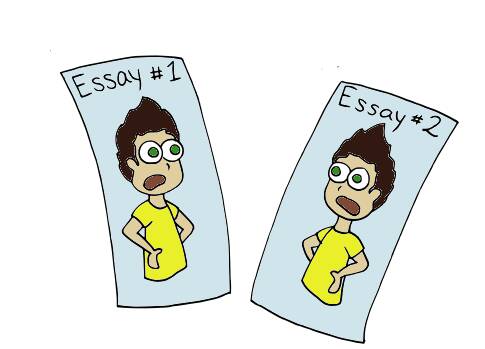109 Plagiarism and Self-Plagiarism
Plagiarism involves integrating another person’s ideas and intellectual material into your writing without giving them credit or citing them. In nursing, you will cite sources including peer-reviewed journals, textbooks, and websites. It might seem funny, but you can also plagiarize yourself: self-plagiarism is a type of plagiarism where you don’t reference ideas that you previously wrote about in other assignments.
Why do people plagiarize?
Sometimes a writer plagiarizes work on purpose, for example, by copying and pasting or purchasing an essay from a website and submitting it as original work. See Figure 9.2. This may happen because the writer has not managed their time and has left the paper to the last minute, or has struggled with the writing process or the topic. This can lead to desperation and cause the writer to take credit for someone else’s ideas.
In other cases, a writer may commit accidental plagiarism due to carelessness, haste, or misunderstanding. A writer may be unable to provide a complete, accurate citation because they neglected to record the bibliographical information, for example, by cutting and pasting from a website and then forgetting where the material came from. Or, a writer who procrastinates may rush through a draft, which easily leads to sloppy paraphrasing and inaccurate quotations. These careless actions can create the appearance of plagiarism and lead to negative consequences.
Both types of plagiarism have serious consequences that can affect your success in your program.

Figure 9.2: Plagiarism
Turnitin
Turnitin is a tool that helps instructors identify plagiarism. Your instructor may provide a link for you to submit your paper to the Turnitin website for scanning. This detection service compares your writing to a vast collection of writing (including Internet sources and other student papers) from around the world. It uses a similarity index to identify components of your writing that are similar to other sources. Don’t plagiarize – turnitin will catch you!
How to avoid plagiarism?
You can avoid plagiarism by following these simple rules (also, see Film Clip 9.2):
- Start by writing what you know about a subject, turning to sources only when you need to support your own ideas with authoritative backing or when there’s a knowledge gap you cannot fill on your own. Or, of course, to satisfy requirements required by your instructor, who may require you to cite a certain number of sources to support your writing. Even then, most of the work should be your own.
- Take notes carefully. If you add source material to your work, mark it or identify it in such a way that you will know it’s from a source. Cite the work immediately and add it to your reference list.
- If you use someone else’s intellectual property, you must give them credit.
- Changing a few words from a source and presenting it as your own is still plagiarism. Carefully follow guidelines on how to paraphrase and quote source material, coming up on the next page.
Film Clip 9.2: Avoiding plagiarism [2:00]
Student Tip
Previously Graded Work
Most instructors will not permit you to submit previously graded work in their course, and using your own ideas from previous assignments can place you at risk for self-plagiarism. You should try to choose a completely different topic to avoid the temptation to reuse previously submitted work. However, an instructor will sometimes ask you to build on your ideas from a previous paper; in this case, you might want to have a discussion with the instructor about self-plagiarism.
Activities: Check Your Understanding
Attribution statement
The section about “Why do people plagiarize?” is an adaptation of (editorial changes):
Writing for Success 1st Canadian Edition by Tara Horkoff, licensed under a Creative Commons Attribution-NonCommercial-ShareAlike 4.0 International License, except where otherwise noted. Download for free at: https://opentextbc.ca/writingforsuccess/
The section about “How to avoid plagiarism? is an adaptation (editorial changes) of:
The Word on College Reading and Writing by Carol Burnell, Jaime Wood, Monique Babin, Susan Pesznecker, and Nicole Rosevear, licensed under a Creative Commons Attribution-NonCommercial 4.0 International License, except where otherwise noted.Download for free at: https://openoregon.pressbooks.pub/wrd/

